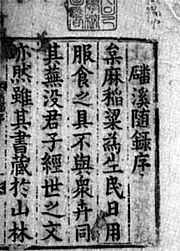Yu Hyeongwon facts for kids
| Korean name | |
| Hangul |
유형원
|
|---|---|
| Hanja |
柳馨遠
|
| Revised Romanization | Yu Hyeongwon |
| McCune–Reischauer | Yu Hyǒngwǒn |
Quick facts for kids Art name |
|
| Hangul |
반계
|
| Hanja | |
| Revised Romanization | Ban'gye |
| McCune–Reischauer | Pan'gye |
Yu Hyeongwon (1622–1673) was an important Korean thinker and government official. He lived during the Joseon Dynasty in Korea. He was one of the first people to promote a new way of thinking called silhak. This word means "practical learning."
Yu Hyeongwon was also a Neo-Confucianist scholar. This was a popular way of thinking in Korea at the time. He was known for being a social critic. This means he looked at society and suggested ways to make it better.
He was a student of Misu Heo Mok. He was also a cousin of another famous Silhak scholar, Seongho Yi Ik. Yu Hyeongwon came from the Munhwa Yu clan. Many people in his family held important jobs in the Joseon government.
What Was Silhak?
Silhak was a new way of thinking that became popular in the late Joseon period. It focused on practical solutions for real problems. Scholars like Yu Hyeongwon believed that learning should help improve people's lives. They wanted to fix issues in farming, government, and education.
Yu Hyeongwon's Main Ideas
Yu Hyeongwon believed in fair land distribution. He thought that all farmers should have land to work on. This idea was very new for his time. He also wanted to change how government officials were chosen. He thought people should be picked based on their skills, not just their family background.
His Famous Book
Yu Hyeongwon wrote many books and papers. His most famous work is called Bangyesurock (반계수록). In this book, he wrote down all his ideas for improving Korea. He talked about land reform, government changes, and how to make society more just. This book became very important for later Silhak scholars.
See also
- Yi Sugwang
- Yu Suwon
- Heo Mok
- Yun Hyu
- Yi Seou
- Yi Ik
- Jeong Yakyong
Site Link
- Yu Hyungwon
- Découvrez la forteresse de Hwaseong entourant le centre de Suwon en Corée du Sud
- 1656 – "Yojiji (輿地志)" by Ryu Hyung-won (柳馨遠) didn't say "Usan is so-called Japanese Matsushima."


